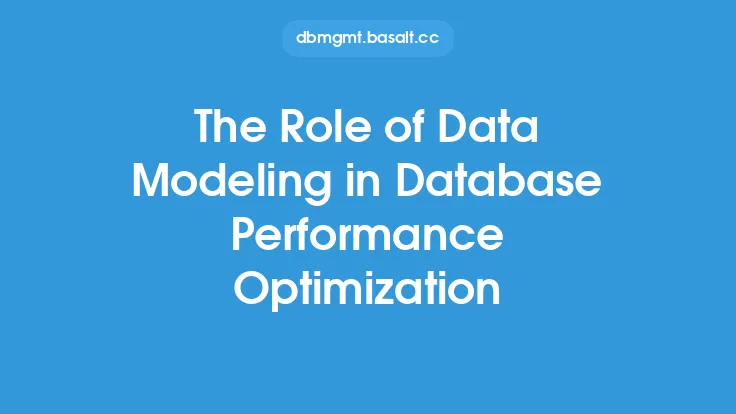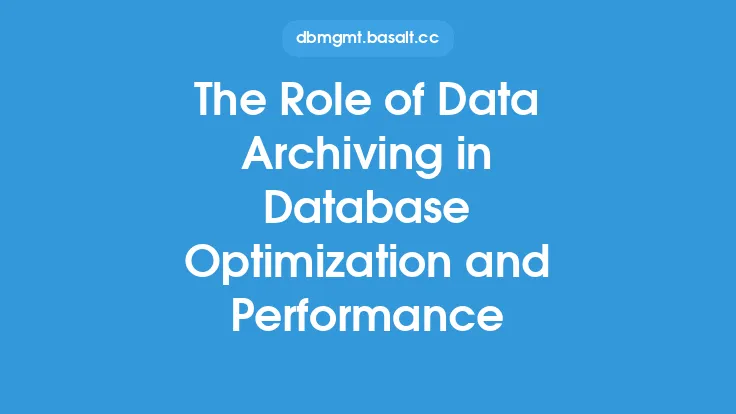When it comes to optimizing database queries, one technique that is often overlooked is denormalization. Denormalization is the process of intentionally deviating from the principles of normalization in order to improve the performance of a database. Normalization is the process of organizing data in a database to minimize data redundancy and dependency, but it can sometimes lead to slower query performance. Denormalization, on the other hand, involves duplicating data or grouping data in a way that reduces the number of joins required to retrieve data, resulting in faster query execution.
Introduction to Denormalization
Denormalization is a technique that is used to improve the performance of a database by reducing the number of joins required to retrieve data. In a normalized database, each piece of data is stored in one place and one place only, which can lead to slower query performance. By denormalizing the data, you can reduce the number of joins required to retrieve data, resulting in faster query execution. However, denormalization can also lead to data inconsistencies and increased storage requirements, so it should be used judiciously.
Types of Denormalization
There are several types of denormalization, including data duplication, data aggregation, and data grouping. Data duplication involves duplicating data in multiple tables, which can reduce the number of joins required to retrieve data. Data aggregation involves storing aggregated data, such as sums or averages, in a separate table, which can reduce the number of calculations required to retrieve data. Data grouping involves grouping data into a single table, which can reduce the number of joins required to retrieve data.
Benefits of Denormalization
The benefits of denormalization include improved query performance, reduced storage requirements, and improved data retrieval. By reducing the number of joins required to retrieve data, denormalization can improve query performance and reduce the load on the database. Denormalization can also reduce storage requirements by eliminating the need for redundant data. Additionally, denormalization can improve data retrieval by providing a single source of truth for data.
Challenges of Denormalization
Despite the benefits of denormalization, there are also several challenges to consider. One of the main challenges of denormalization is data inconsistency, which can occur when data is duplicated or aggregated. Data inconsistency can lead to incorrect results and can be difficult to resolve. Another challenge of denormalization is increased storage requirements, which can occur when data is duplicated or aggregated. Increased storage requirements can lead to higher costs and reduced performance.
Best Practices for Denormalization
To get the most out of denormalization, it's essential to follow best practices. One of the most important best practices is to denormalize only the data that is necessary, as denormalizing too much data can lead to data inconsistency and increased storage requirements. Another best practice is to use indexing and caching to improve query performance, as these techniques can reduce the load on the database and improve data retrieval. Additionally, it's essential to monitor the database regularly to ensure that denormalization is not leading to data inconsistency or increased storage requirements.
Denormalization Techniques
There are several denormalization techniques that can be used to improve query performance, including pre-aggregation, pre-joining, and data warehousing. Pre-aggregation involves storing aggregated data, such as sums or averages, in a separate table, which can reduce the number of calculations required to retrieve data. Pre-joining involves storing joined data in a separate table, which can reduce the number of joins required to retrieve data. Data warehousing involves storing data in a separate database that is optimized for querying and analysis, which can improve query performance and reduce the load on the database.
Denormalization and Database Design
Denormalization can have a significant impact on database design, as it requires a different approach to data modeling and schema design. When denormalizing a database, it's essential to consider the trade-offs between data consistency, storage requirements, and query performance. One approach to denormalization is to use a star or snowflake schema, which involves storing data in a centralized table with related data stored in separate tables. Another approach is to use a data warehouse, which involves storing data in a separate database that is optimized for querying and analysis.
Denormalization and Query Optimization
Denormalization can also have a significant impact on query optimization, as it requires a different approach to query planning and execution. When denormalizing a database, it's essential to consider the query patterns and optimize the database accordingly. One approach to query optimization is to use indexing and caching, which can reduce the load on the database and improve data retrieval. Another approach is to use query rewriting, which involves rewriting queries to take advantage of denormalized data.
Conclusion
In conclusion, denormalization is a powerful technique that can be used to improve the performance of a database. By reducing the number of joins required to retrieve data, denormalization can improve query performance and reduce the load on the database. However, denormalization can also lead to data inconsistencies and increased storage requirements, so it should be used judiciously. By following best practices and using denormalization techniques, such as pre-aggregation and data warehousing, you can get the most out of denormalization and improve the performance of your database.





